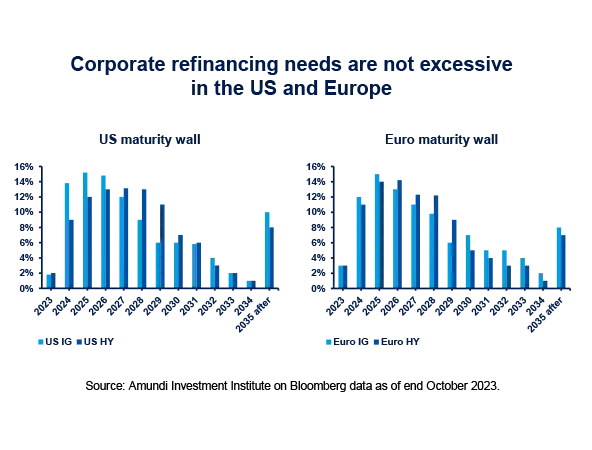KEY TAKEAWAYS
- Global corporate yields remain attractive
- Corporate fundamentals are sound
- The yield curve has started to normalize and is expected to favor longer maturities
- Active managers are well positioned to capture attractive opportunities globally
After a series of aggressive rate hikes throughout the past couple of years, all eyes are on central banks; the focus is on the timing and magnitude of their monetary policy decisions, with the ECB leading the way and beginning its pivot by cutting rates by 25bps in each of June, September, and October, bringing rates down to 3.25%, the lowest since May 2023. The Federal Reserve cut interest rates by 50bps in September 2024, marking the first reduction since March 2020. Continuing its efforts to stimulate the economy, the Federal Reserve announced another rate cut in November, this time by 25bps, bringing the rate down to 4.75%.
In our view, this easing scenario should progressively lead to a yield curve normalization, driving investors to reassess their fixed income allocations towards longer duration products, as short-term yields decline, with longer duration solutions becoming more remunerative once again.

Nevertheless, as shown in the yield evolution chart, there is no need to constantly anticipate central banks’ future actions, as current yield levels remain attractive. Yields in the global corporate universe are nearly 5% (in EUR).
Such enticing yields could act as a cushion against potential risk-off movements, where investors shift from higher-risk assets to safer ones, and even help offset bond price declines in the unlikely event that central banks opt for further rate hikes.
The golden moment for credit is evident from corporate data, despite an uncertain economic backdrop, with 2023 characterized by extraordinary events in the US and Europe, including the regional banking crisis, Credit Suisse’s acquisition by UBS, and a US sovereign rating downgrade, and 2024 marked by ongoing geopolitical tensions and risks. Although these challenges exist, we can observe that corporations are holding strong. They have been able to lock in lower yields over the past decade, which has been characterized by accommodative monetary policies. In our view, it will take time for issuers to be impacted by rising debt costs.


At a geographic level, we find European credit markets to be the most appealing, particularly when compared to the high valuations of US credit.
Given that different regions have experienced varying levels of performance relative to each other over time due to a range of factors, this underscores the advantage of active managers. They possess the flexibility to seek out attractive opportunities across the entire global corporate landscape.
Learn more about Amundi’s global fixed income offerings

Amundi Funds Global Corporate Bond

Amundi Funds Global Aggregate Bond
Unless otherwise stated, all information contained in this document is from Amundi Asset Management S.A.S. and is as of 7 November 2024. Diversification does not guarantee a profit or protect against a loss. The views expressed regarding market and economic trends are those of the author and not necessarily Amundi Asset Management S.A.S. and are subject to change at any time based on market and other conditions, and there can be no assurance that countries, markets or sectors will perform as expected. These views should not be relied upon as investment advice, a security recommendation, or as an indication of trading for any Amundi product. This material does not constitute an offer or solicitation to buy or sell any security, fund units or services. Investment involves risks, including market, political, liquidity and currency risks. Past performance is not a guarantee or indicative of future results.
Date of first use: 20 November 2024
Doc ID: 3570181
For professional investors only
